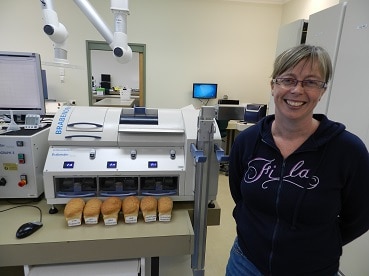Quantifying quality under elevated CO2
The impact of rising atmospheric carbon dioxide (CO2) levels on Australia’s grains industry is being closely examined by scientists involved in the Australian Grain Free Air CO2 Enrichment (AGFACE) program at Horsham in the Victorian Wimmera.
With CO2 levels predicted to rise by about 40 per cent over the next 40 years, the AGFACE program – a joint initiative of the Department of Primary Industries, the University of Melbourne and the GRDC – was set up in 2007. The objective was to provide tools and information that will enable the grains industry, through policy makers and pre-breeders, to remain productive and competitive despite changes in climate.
According to researchers, increases in atmospheric CO2 will bring with it both benefits and challenges. Because CO2 acts as a fertiliser, it promotes improved water use efficiency, plant growth and yield, but under elevated levels grain quality is reduced. AGFACE scientists are investigating how the grains industry might realise the potential of this ‘CO2 fertilisation effect’ while maintaining grain quality, and under which conditions it will be beneficial.
The aim is to identify the combination of management techniques and germplasm that will ensure sustainable production in the Australian grains industry under future environments.
The program
The AGFACE program seeks to gain knowledge of cultivar traits and cropping systems capable of performing under elevated atmospheric CO2. BCG (Birchip Cropping Group) is involved in an extension capacity, charged with the task of raising awareness about the AGFACE program and the work being done to address issues that will emerge as a consequence of rising CO2 levels.
As well as looking at traits future varieties will need, AGFACE researchers are working on projects focusing on grain quality (including the impact on bread and noodle making), increased nitrogen uptake and how pulse and wheat rotations can address this, the behaviour of pests and diseases in an elevated CO2 environment and below-ground processes.
A laboratory without walls
AGFACE research involves fully replicated wheat trial plots grown under CO2 levels expected in 2050 (550 parts per million) and compared with plots grown under the current CO2 concentration (370ppm).
The research takes place at a purpose-built facility at Horsham which achieves elevated CO2 levels by means of a cleverly engineered system that sees CO2 injected into the atmosphere from pipes circling the research plots. The Horsham facility is one of only six such sites operating in agro-ecosystems internationally and the only one in the southern hemisphere. It is also the only FACE site in the world representing low rainfall, rain-fed grain production.
In 2010, 2011 and 2012 wheat cultivars grown at the Horsham facility included Janz, Silverstar, Yitpi and H45. Large scale quality analyses were completed on the machine harvested wheat samples.
Grain quality
According to data collected so far, elevated CO2 has been found to adversely affect important grain traits such as protein content, mixing properties and baking properties, as well as the micronutrients in wheat.
However, different wheat cultivars interact differently when grown under elevated CO2 conditions which will allow breeders to select for adaptations.
For the past three years, the wheat quality research team at DEPI Horsham have examined how elevated CO2 effects grain protein, grain weight and screenings, endosperm hardness and test weights.
But the program goes a step further, with the wheat milled and the flour’s baking and milling qualities examined. Elements such as dough rheology, flour colour, milling yield, dough mixing properties, water uptake, mixing stability, dough strength and extensibility are all tested.
Protein is a major determinant for processing quality and there have been significant decreases in grain protein under elevated CO2 levels.
Research scientist Cassandra Walker said depending on variety, wheat grown under elevated CO2 was generally one to 1.5 per cent lower in grain protein content than its equivalent grown under ambient conditions.
Additionally, dough rheology properties were adversely affected by elevated CO2 which is significant from a baking perspective.
“Potential, grain now classified as AH could become ASW,” Ms Walker said.
“But some varieties aren’t as affected as others.”
The impact of elevated CO2 is especially evident after baking with loaves made from wheat grown under elevated CO2 smaller and denser (up to a 10 per cent reduction in volume).
“A likely consequence of this reduction in baking quality is increased baking costs and a demand for higher quality wheat,” Ms Walker said.
“This would flow on to the farmer with increased input costs, particularly in terms of fertilisers and nutrients.”
Nutritional changes
AGFACE research also indicates that in the future wheat micronutrients could be reduced as a consequence of higher CO2 levels.
AGFACE project leader Glenn Fitzgerald said while this effect is less well documented, it is critical to future human and animal nutrition and food security.
“Changes in grain nutritional qualities would impact people most severely in developing nations where much of the food consumed is plant based,” he said.
“These aspects are being actively studied in AGFACE.”
Where to from here?
Maintaining productivity in the future will require new crop cultivars that can maintain yield and grain quality under elevated CO2 in conjunction with changes in rainfall patterns and increasing temperatures.
So far the research has found the quality premium grade wheats such as Yitpi and Janz suffer greater effects of elevated CO2 than H45 or Silverstar.
The AGFACE facility is helping researchers to provide vital information on benchmarking cultivars such as Janz and Yitpi and monitor potential new cultivars.
Data from this research will help ensure key quality parametres such as protein content, dough rheology and loaf volume, are not compromised as CO2 increases in the future.

